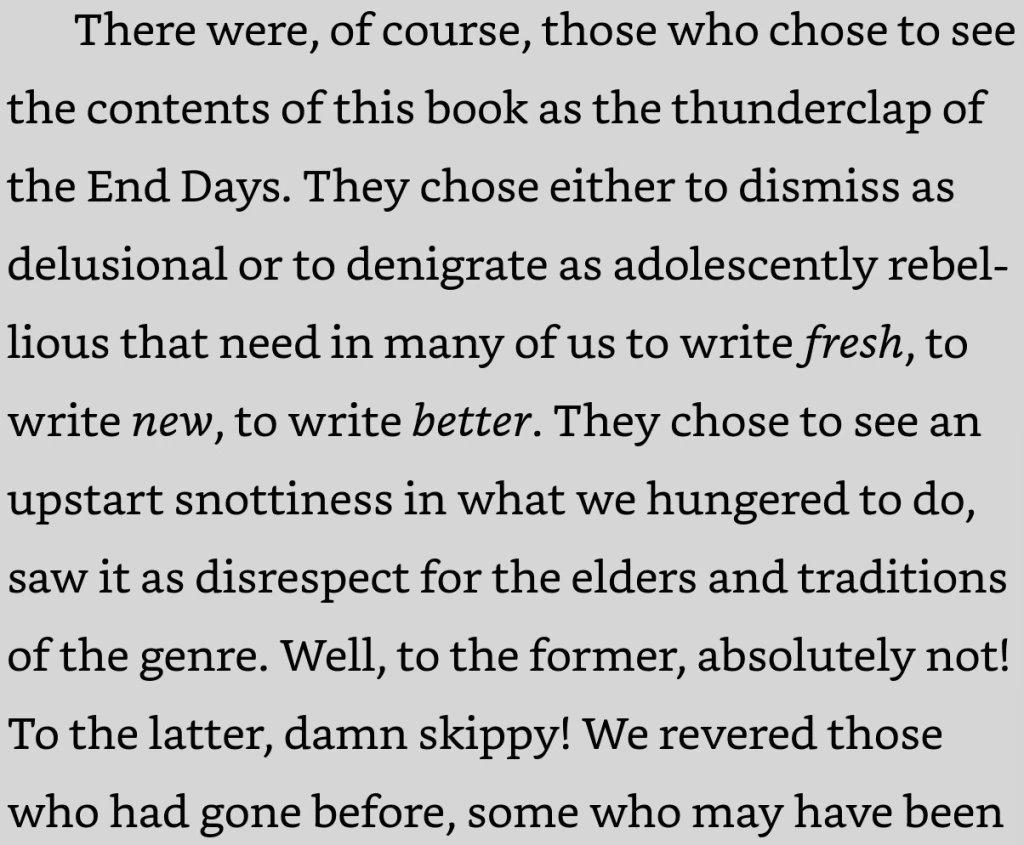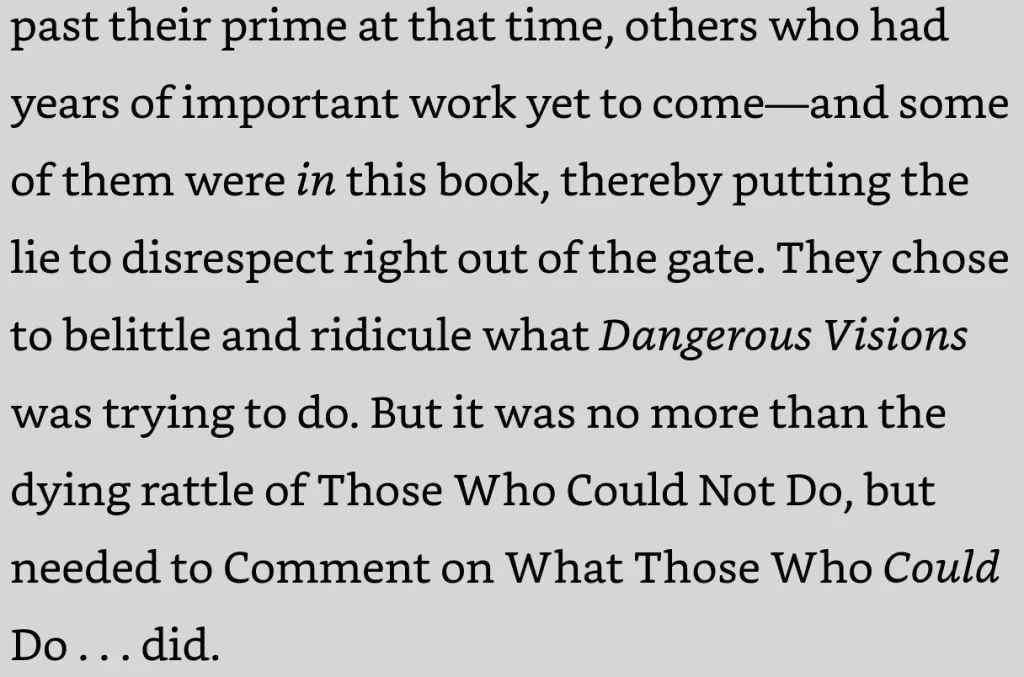Starting May 5, 2024, our Facebook group read for Sundays will be Dangerous Visions edited by Harlan Ellison. It will be designated GR76W. I thought I’d announce it today so people will have a week to get a copy of the book. There’s a new edition with a new a foreword and introduction, that also includes the 2002 foreword and introduction, and two forewords from the original 1967 edition. Otherwise, the stories are the same. If you have the older editions already, you can read all the forewords and introductions online at Amazon in the Read Sample feature.
I’m going to go over all those forewords and introductions to analyze all the claims for the book that’s been made since 1967. Dangerous Visions is probably the most famous science fiction anthology ever, yet I’m not sure if it ever lived up to the hype. I’m going to cover the forewords and introductions in reverse order.
Foreword 2: “Harlan and I” by Isaac Asimov
It’s interesting Ellison includes two forewords by Asimov, especially since they’re mainly about the two men trading insults. Asimov does not have a story in this collection, and I’m not sure if Asimov isn’t offering the sales value of his name in exchange for slyly warning the reader about Harlan Ellison, who wasn’t famous in 1967, and is one pugnacious little guy.
As we’ll come to see, Dangerous Visions is really all about Harlan Ellison. The success of this anthology is due completely to Ellison’s force of will. And this new 2024 edition is a tribute to his memory. I highly recommend renting Dreams with Sharp Teeth, a documentary about Harlan Ellison. It’s $3.99 at Amazon. Here’s a trailer.
Foreword 1: “The Second Revolution” by Isaac Asimov
In this forward Asimov talks about himself, which was typical, and about the history of science fiction leading up to 1967. Asimov describes Campbell’s Golden Age as the First Revolution in science fiction, and what we’ll be reading in this anthology represents the Second Revolution in science fiction. Readers back in 1967 didn’t know it yet, but this new type of SF will soon be labelled The New Wave in science fiction, something Michael Moorcock and the writers at New Worlds in England had already exploring since the early sixties, and that Judith Merril would call The New Thing in her 1968 anthology England Swings SF. What was great fun was reading all the arguments over New vs. Old in Science Fiction Review in the coming years. That was a fanzine published by Richard Geis that won many Hugo awards. You can read old issues of that fanzine here.
Since its publication, Dangerous Visions has gotten the reputation for being a groundbreaking anthology of New Wave writing. I don’t think Ellison anticipated that. He aimed to be groundbreaking, but I don’t think he intended to start the new wave in science fiction.
Introduction to the 2002 Edition by Harlan Ellison
In this piece, Ellison does a lot of bragging, but it’s been thirty-five years, and he knows how successful and influential Dangerous Visions has been. He asserts that the anthology was a milestone, not because his ego believes it, but because everyone else believes it. But he also says:


Did this really happen? I think over the thirty-three weeks we’ll be discussing Dangerous Visions we need to decide if Ellison was right or not. Was Dangerous Visions the shape of things to come in science fiction? And did the old-style science fiction die off? Personally, I believe readers tried New Wave science fiction, digested it, and then spit out the rest. What happened was another new wave hit in the 1980s after Star Wars came out, when new writers, often with university creative writing experience, entered the genre, and aimed to write SF best sellers. Their work wasn’t daring or literary, but modern writing styles applied to retreading old science fiction themes.
Foreword to the 2002 Edition by Michael Moorcock
I’m surprised by what Moorcock says. He seems to give Harlan Ellison all the credit for the New Wave without even telling how he got the ball rolling in the first place.
What Ellison did next was the hard bit. By any means he knew—by challenging, by cajoling, by flattery and by confrontation—he persuaded the most brilliant Anglophone writers to raise their own standards and offer the world their personal best. He paid them top dollar for it, too—exceeding his publisher’s budget and reaching deep into his own pockets. And he didn’t stop there. He wrote a commentary, beginning with an introduction and running through the whole book, talking about his contributors, their talent and their potential. Singlehandedly he produced a new benchmark, demanding that in future nothing anyone of any ambition did should fall below that mark. He did what we had, as visionaries, wanted to do. He changed our world forever. And ironically, it is usually a mark of a world so fundamentally altered—be it by Stokely Carmichael or Martin Luther King, Jr. or Lyndon Johnson, or Kate Millett—that nobody remembers what it was like before things got better. That’s the real measure of Ellison’s success.
I believe that we need to remember this while we read the stories from Dangerous Visions. Was Moorcock, right? Did the DV writers set a new standard for writing science fiction? Did it change the genre?
Introduction to the Blackstone Publishing Edition of The Dangerous Visions Trilogy by J. Michael Straczynski
Straczynski greatly admired Harlan Ellison, and he’s doing everything he can to elevate and remember Ellison for new editions of the Dangerous Visions anthologies, and a greatest hits collection of Ellison’s own stories.
Straczynski talks about how writers in America have faced censorship and self-censorship. He puts Ellison and Dangerous Visions into a much larger context. He brings up Ralph Ellison, J. D. Salinger, John Steinbeck, F. Scott Fitzgerald, and Harper Lee. Has any science fiction writer ever been in that league of writers?
In the original foreword Ellison claims that science fiction writers couldn’t write what they wanted because science fiction magazine editors wouldn’t or couldn’t accept stories about certain topics. It’s also implied that old style science fiction was poorly written. I think as we discuss the Dangerous Visions stories 2024, we need to judge them by those two assertions.
My goal for this group read is to decide if the stories in Dangerous Visions couldn’t be expressed or published before 1967, and were they written to a higher literary standard that uplifted the genre. Was the anthology truly ground breaking, or just a tremendous sales pitch by Harlan Ellison?
James Wallace Harris, 4/28/24
“He aimed to be groundbreaking, but I don’t think he intended to start the new wave in science fiction.”
I’d say, without trying to be obnoxious: maybe because he didn’t. That was started years earlier, in New Worlds magazine. Ellison capitalized on it.
I too enjoyed the intros and afterwords more than the stories themselves. The biography and commentary.
LikeLike